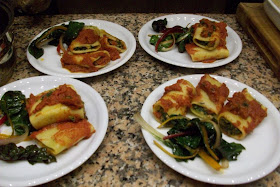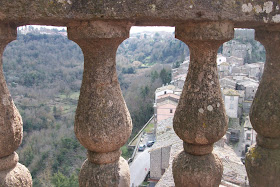 |
| Fulvio enjoys lunch with French and Finnish friends |
Today is Easter Sunday and while many of you are preparing, eating or digesting your Easter
dinner, I hope you enjoy a glimpse of
life here in central Italy during this unseasonably
chilly Easter season.
 |
| orange salad with olives and onion |
Fireplaces were lighted
and the atmosphere was warm at
lunch with friends in the
medieval section of Vetralla and also in
the evening for the a celebratory birthday
dinner near the Etruscan site of Castel d’Asso, Viterbo.
The variety of delicious dishes prepared
by our two hostesses (one Japanese, the other English) and the
congenial international
company made for a wonderful, busy day.
 |
| bresaola & radicchio salad |
Lunch started
with spumante and grissini, then
a series of antipasti including local cheese with
patè di cipolle rosse, sun dried tomatos, bresaola and radicchio
 |
| pumpkin ginger soup |
garnished with
nuts, pumpkin-ginger soup,
orange and onion salad, cous cous with shrimp, green beans and rucola.
 |
| cous cous with shrimp |
Delicious
pears baked in grappa and stuffed with raisins ended the lunch along
with locally baked biscotti and a
selection of liquor from Germany
and Sardegna.
I was too busy enjoying the meal and good company to worry about photos, so they do not do justice
to the food.
 |
| celebratory birthday dinner |
The
torrential rain stopped long enough in
the evening for the drive to the country house where the
birthday dinner was being held. After a toast we enjoyed an antipasto of spring rolls,
mussels au
gratin and anchovies on buttered bread.
Next came
manicotti pasta stuffed with spinach and crab meat garnished with steamed garden greens.
 |
| manicotti stuffed with spinach and crab |
This was followed
by discs of polenta with tender calamari in their black ink.
 |
| polenta and calamari |
The next course was monkfish saltimbocca dressed with bean
pure and colorful dabs of basil and peppers.
The
dessert of individual molten chocolate
cakes and panna ended the meal but not before some hilarity brought
on by a chocolate Easter chicken.
Tomorrow is Pasquetta or Lunedi del Angelo, usually
the first day Italian families get together,
weather permitting, for a picnic. The
menu includes artichokes (carciofi alla nonna Agnesina),
pizza di Pasqua and traditional lamb
which will be roasted over the fire for
several hours.

















































